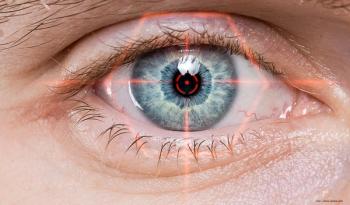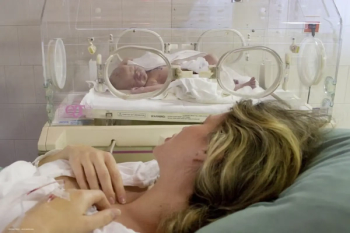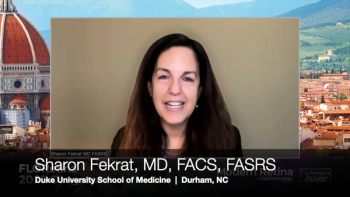
- Ophthalmology Times Europe January/February 2025
- Volume 21
- Issue 1
- Pages: 12 - 15
Shifting the narrative around dry eye disease
A qualitative study method illuminates patients’ fears for the future
Dry eye disease (DED) is one of the most common ocular conditions, and patients with the disease may experience a wide range of severity and progression. A recent study completed by researchers in Italy shone light on the often-overlooked aspects of DED by applying a narrative medicine approach.
Researchers working on the project collected data from 38 eye care centres in Italy and one in San Marino. Respondents included adult patients with DED, their informal caregivers and ophthalmologists caring for the patient base.1 The authors collected demographic data as well as written narratives which illustrated quality-of-life (QoL) factors via an anonymous collection portal. In total, 171 patients diagnosed with DED participated in the research, as did 37 informal caregivers (family members or friends). Among patients, 38% had moderate DED, 27% reported severe DED and 14% stated that they were not informed about the severity of their DED. Of the completed narrative questionnaires, 163 patient narratives and 35 caregiver narratives were analysed, and 81 ophthalmologists composed 111 parallel charts to illuminate the clinical factors of the patients’ experiences.
Emanuela Aragona, MD, PhD, from the IRCCS San Raffaele Scientific Institute, University Vita-Salute San Raffaele in Milan, Italy, spoke with Ophthalmology Times Europe about the research. Dr Aragona, an author of the study, also presented the results as a poster at the 2024 Tear Film & Ocular Surface Society (TFOS) Conference in Venice, Italy, held from 30 October to 2 November, 2024.
“The narrative medicine approach was a bit of a challenge for us as researchers because it was something that we were not so used to. It is very commonly used in other medical fields, such as oncology, where studying the impact on QoL of both diseases and treatments is much more common,” Dr Aragona said. Narrative medicine is also quite different from questionnaires, which use precisely selected and defined terms to reach a quantitative conclusion. Narrative medicine gives respondents a greater degree of freedom. “Patients were prompted to write sentences which answered questions like ‘What are your overall feelings about your experience of dry eye disease? Your treatment?’ and ‘What are your most frequent fears about your future?’” Dr Aragona said. “After that part, we completed an evaluation of the terms that were used most commonly.”
Analysis of the narratives revealed common themes, which appeared in quotes from patients, caregivers and ophthalmologists (Table). All parties frequently mentioned the physical experience of DED, including discomfort and pain, and the burden of using eye drops and other avenues of relief multiple times per day. Patients and caregivers reported drastic impacts of DED at home and in the workplace: daily activities, such as driving, computer work, cooking and leisure reading, became impossible for some patients. Caregivers who assumed those patients’ responsibilities reported feelings of overwhelm, anxiety and resentment at the care burden. The economic impact of DED was magnified by patients’ limited ability to work, and many patients said the cost of their treatment affected their families’ budgetary needs.
“One patient said to me, ‘So, I have to treat this disease for the rest of my life?’” Dr Aragona recalled. “They said it feels like they have all the existing burdens of daily life, and now, adding to that, they must manage a disabling, chronic disease. This points toward durability as a priority for future treatments, such as anti-inflammatory drugs that could work for a longer period of time or be more active on the pathogenesis of the disease.”
In conversation with caregivers
Dr Aragona highlighted the inclusion of caregivers in the narrative research project. The family members and friends who serve as informal caregivers are frequently excluded from QoL research, she said, but this study revealed new findings on caregivers’ perception of DED. “The most surprising result was related to the caregivers. We found that 35% of caregivers surveyed considered dry eye disease to be a disabling condition,” Dr Aragona said. “The patients only made this kind of evaluation in 19% of cases.”
Many of the caregivers surveyed said that caring for their family members with DED necessitated major life changes. As an example, Dr Aragona recalled the experience of one young woman who left her university, putting her studies on pause in order to care for a parent with DED. “In the past, we haven’t had so many data regarding the broader impact on patients’ families,” Dr Aragona said.
Caregivers reiterated a common response from patients which emphasised the doctor-patient relationship. Among patients surveyed, 70% said that the therapeutic alliance with their doctor is fundamental to the treatment’s success. “Both caregivers and patients said they prioritised a relationship with a doctor who could really understand their problems and suffering. I think most of the patients felt a bit lost,” Dr Aragona said. “In my everyday practice, I have experienced that patients who come to me say they feel as though other ophthalmologists did not believe in their levels of pain and suffering... Dry eye is a really complex disease where there are critical symptomatic aspects, including pain, which are sometimes not in accordance with the clinical signs.”
Among the patient respondents, 11% said they craved a sense of constancy or consistency in the therapies used to treat DED, and 14% reported ineffective treatments.
Looking to the future
Patients were encouraged to share their fears for the future, and the most common responses included a worsening of the condition and treatments losing efficacy or not being completely effective, Dr Aragona said. Interestingly, while only 5% of patients said they hope DED sees heightened awareness in the future, 22% of caregivers advocated for increased research efforts and improved treatment access. Caregivers were also less likely to describe patients’ QoL as “good,” and more likely to describe patients’ QoL as “poor” (Figure).
Future therapeutics may require a different approach than traditional treatments for ocular pain, Dr Aragona said.
“Pain is, really, a very subjective experience. Newer research is assessing pain independently of other clinical [observations]. I think this is becoming a more important aspect that we consider in our evaluations of dry eye disease, and there’s still space to improve,” Dr Aragona said. “I think that we are starting to better understand the different pathological connections between ocular pain, pain disorders, ocular surface diseases and dry eye disease. I hope that there will soon be more therapeutic approaches which focus on pain as patients with dry eye disease experience it. There is a difference between pain related to dry eye symptoms and pain derived from the sensitisation of the central nervous system.” Some of the ophthalmologists surveyed echoed Dr Aragona’s sentiments: 26% said that DED awareness should be raised among their colleagues and patients.
Dr Aragona said that narrative medicine projects such as this one could help pinpoint patients’ therapeutic needs in a way that traditional clinical research does not. After presenting the research at the TFOS Congress, she said, reactions from her colleagues indicated a growing interest in narrative medicine.
“The study received a really good reception from the audience of international ophthalmologists, and there was great interest in narrative medicine as a new way to study patients’ quality of life,” she said. “The day after the presentation of the posters, one opinion leader in dry eye came back to me and asked for more details on the narrative medicine approach, and said that it was a novel idea he would consider more.”
Patients who participated in the project reported positive outcomes from sharing their stories, which could bode well for the future of narrative medicine. According to the authors, 65% of patients described writing as a positive experience (46% of caregivers and 47% of ophthalmologists reported the process was a positive experience). One patient said she hoped sharing her story could help other patients: “Many people like me, especially women, suffer,” she said. “I have met other women my age who did not know it is a disease, and [they] endured, and worsened, to avoid bothering others.” Dr Aragona said that narrative medicine could help shape future therapies and help researchers understand aspects of DED which are missed in questionnaires or clinical trials. “I do think and hope narrative medicine will be used more broadly in the future to evaluate therapeutics’ impact on patients,” Dr Aragona said.
Reference
1. Aragona P, Barabino S, Akbas E, et al. Utilising narrative medicine to identify key factors affecting quality of life in dry eye disease: an Italian multicentre study. Ophthalmol Ther. 2024;13(11):2965-2984. doi:10.1007/s40123-024-01033-7
Emanuela Aragona, MD, PhD | E: [email protected]
Dr Aragona has concluded her PhD project at Vita-Salute San Raffaele University and is currently an ophthalmologist in IRCCS San Raffaele Scientific Institute in Milan. Her everyday activity deals with patients affected by dry eye disease.
Articles in this issue
10 months ago
IOL design puts a new spin on vision10 months ago
Helping patients with glaucoma manage mental health10 months ago
A new home treatment for amblyopiaNewsletter
Get the essential updates shaping the future of pharma manufacturing and compliance—subscribe today to Pharmaceutical Technology and never miss a breakthrough.













































